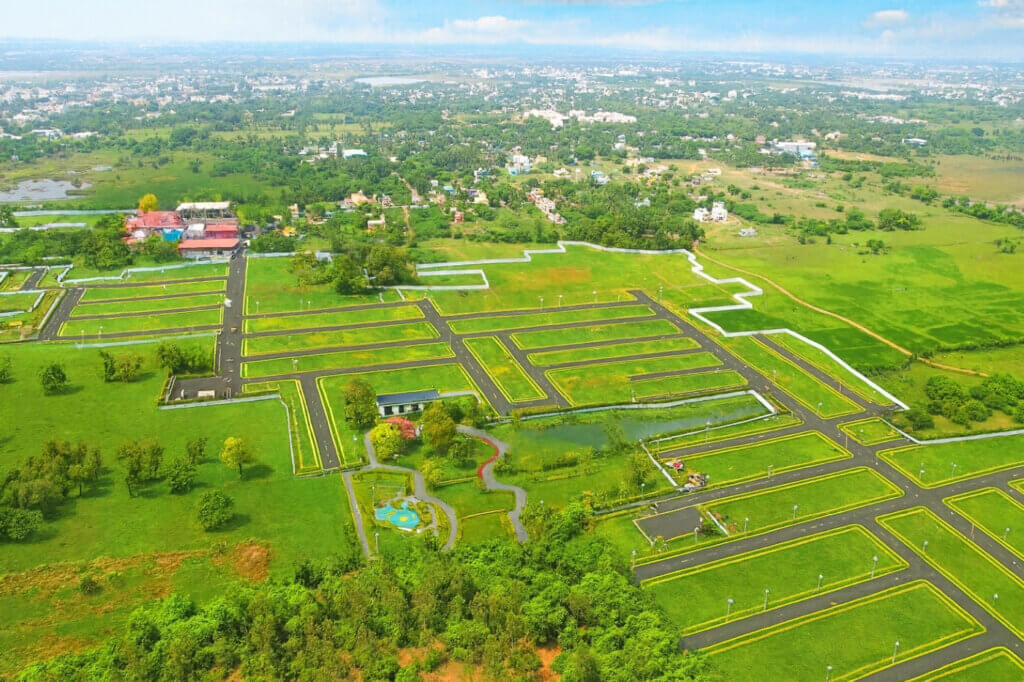Sometimes the smartest home upgrade is right under your feet. Permeable paving quietly soaks rain where it falls, keeps your plot usable in heavy showers, and supports groundwater recharge for the long term. If you are planning a sustainable home in Padappai or the wider Oragadam belt, this is a simple move with big impact.

What is permeable paving and why should you care
Permeable paving is a surface that lets water pass through into the soil below instead of pushing it into drains. In fast-growing suburbs like Padappai, roads and hardscapes are increasing, which means more stormwater on your street and less water underground. Choosing permeable materials around your home helps reduce flooding risk, protects landscape soil, and keeps your borewell healthier over time. It also looks premium when done with the right finish.
How permeable paving supports plot value in Padappai
• Lower waterlogging around your compound during monsoon
• Better groundwater recharge for long term water security
• Cooler microclimate around the house since surfaces breathe
• Less silt and debris flowing into neighbourhood drains
• Attractive texture options that match modern elevations
At Velammal Garden, plots are designed for smart rainwater movement within the layout. When you pair your house design with permeable paving inside the setback, driveway, and garden paths, you get a cleaner frontage and a low-maintenance yard. Explore available plot sizes and planning tips at velammalgarden.com.
Types of permeable paving to consider
• Permeable interlocking concrete pavers
Individual blocks with small joints filled with grit. Strong for driveways, easy to repair, and available in contemporary colours.
• Porous concrete or porous asphalt
Looks seamless yet allows infiltration. Works well for larger parking pads. Needs skilled laying and a well prepared base.
• Natural stone on open joints
Cobblestone or flagstone with wider joints filled with fine aggregate. Premium look and good drainage for walkways and sit-outs.
• Gravel stabilised grids
Plastic or concrete honeycomb grids filled with gravel. Budget friendly for overflow parking, garden paths, and utility areas.
• Resin bound aggregates
Decorative stones bound with resin over a porous base. Uniform finish with good permeability for paths and courtyards.
Where to use it on a villa plot
• Car porch and driveway
• Entrance pathway and side setbacks
• Backyard sit-out and clothes drying zone
• Around rainwater harvesting pits and recharge wells
• Below outdoor seating, pergolas, and garden features
Tip for Padappai soils
Many parts of Padappai have mixed red and clayey pockets. If your soil is heavier, increase the thickness of the drainage layer and use a larger size crushed stone to keep the system breathing.
The layer cake that makes it work
A good permeable pavement is a simple sandwich.
• Surface layer
Pavers or porous surface that lets water through.
• Bedding layer
Clean grit that supports the surface and allows flow.
• Base layer
A thicker layer of open graded aggregate that stores stormwater temporarily.
• Geotextile
Separates soil from aggregate so the system does not clog from below.
• Subgrade
Compacted natural soil graded with a gentle slope toward your recharge point.
Design rules to get right
• Keep surface perfectly level across each small panel but guide the base to a recharge pit or trench.
• Use only clean, washed, angular aggregates for bedding and base. No quarry dust that can block pores.
• Provide an overflow path toward a soak pit or rainwater harvesting well for very heavy downpours.
• Edge restraints are important. Use concrete kerbs or stone borders so pavers do not spread under wheel load.
• Plan utility conduits well in advance. Leave sleeves so later drilling does not disturb the base.
Maintenance made easy
• Quarterly sweep or blower cleaning to remove leaves and silt
• Annual vacuum or pressure wash if joints appear sealed by dust
• Refill joint grit wherever it has settled
• Keep nearby soil beds slightly lower than the paved level so mud does not wash onto the surface
With this basic care, permeable paving keeps its performance for many years in Chennai’s monsoon cycle.
Cost and budgeting pointers
• Material options range from budget gravel grids to premium resin bound finishes
• Installation quality matters more than material grade for long term performance
• Factor in the base layers and geotextile while comparing quotes
• For phased construction, start with driveway and primary walkway, then extend to side setbacks
Simple plan for a Velammal Garden homeowner
• Map traffic zones
Driveway, front entry, side passages, and a utility strip behind the kitchen.
• Pick the system
Interlocking pavers for driveway, gravel grid for side passages, stone on open joints for the sit-out.
• Connect to recharge
Link all permeable areas to a soak pit or RWH well as part of your plumbing drawings.
• Execute with supervision
Check aggregate type, layer thickness, and geotextile placement during laying.
• Document and hand over
Ask your contractor to note maintenance steps and material sources for future top-ups.
For plot planning support and a walk-through of best practices, reach the team at velammalgarden.com. You can also visit the site to see how homeowners are styling driveways and pathways to match modern elevations.
Frequently asked questions on permeable paving reduce runoff recharge groundwater sustainable home Padappai
What is the difference between permeable and normal pavers
Permeable pavers are designed with wider joints and use clean grit so water passes through into the base layer. Normal pavers are laid tight on sand and push water sideways into drains, which can increase runoff during heavy rain.
Will permeable paving handle car loads in a driveway
Yes, when installed with the correct base thickness and edge restraints. Interlocking permeable pavers and porous concrete systems are specifically engineered for vehicular loads. Always follow the specified layer depths for your soil type.
Does permeable paving help my borewell in Padappai
It supports recharge by letting rainfall percolate near your home instead of rushing to the street. When connected to a soak pit or RWH well, it directly feeds the groundwater table, which is valuable for long term water security.
Will weeds grow through the joints
If you use geotextile and clean aggregates, weeds are minimal. A quick quarterly sweep and spot treatment keeps the joints clear. Avoid soil wash from adjacent garden beds by keeping their level lower than the paved area.
Is permeable paving expensive compared to regular paving
Upfront cost can be slightly higher because of the engineered base layers, but you save over time through reduced drainage works, fewer puddles, less heat build up, and better site usability in monsoon. The comfort and sustainability gains often justify the difference.
Final word
If your goal is a sustainable home that stays comfortable through Chennai’s hot months and the northeast monsoon, permeable paving is a high impact, low drama choice. It helps reduce runoff, recharge groundwater, and uplift your home’s look in one go. Plan it once and enjoy a cooler, cleaner plot for years. Visit velammalgarden.com to explore plots and get design guidance for your driveway, sit-outs, and garden paths.


